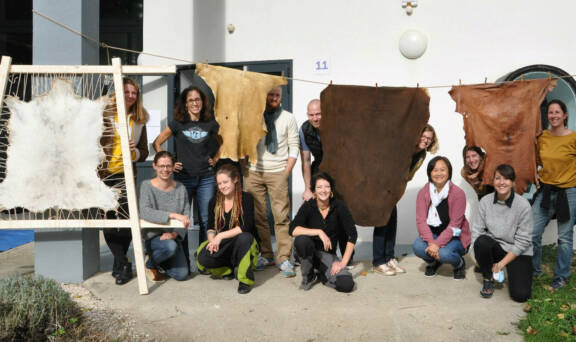A First Encounter with the Collection of Painted Hides
The set of North American painted hides held in French collections is the largest and oldest of its kind anywhere in the world. Fifteen of them, in the musée du quai Branly - Jacques Chirac, date back to the eighteenth century. The hides come from the ethnographic collection of the Cabinet des Médailles, in the French National Library, and from the Versailles Public Library's former "Cabinet of curiosities and of decorative objects" [Cabinet de curiosités et d’objets d’art], which was assembled in 1806 and moved to Paris in 1934.

Yet after more than two centuries in public collections, they still hold many secrets for us: what of their origins, what was their function and what is their history? Attempts to identify and interpret these objects has produced inconclusive results, from fragmentary, often secondary sources.
There are good reasons for this. First, absolutely no research has been done on painted hide production in the 18th century. Secondly, since the items in Paris are the oldest in the world, comparing them with other collections is of limited use. So, in order to shed new light on this exceptional corpus, we have set up a multi-disciplinary research team to work solely from primary sources (original inventory entries, contemporary written documents, etc.) and from material analyses of the painted hides under consideration. This long-term program aims at identifying the hides' origins, and their intrinsic characteristics.

The first research session ran from 22 June to 3 July 2020, and brought together a team of conservators, anthropologists, restorers, and materials and natural science specialists. They started by comparing all the hides, in order to circumscribe lines of inquiry and research, to define what conservation and restoration work was required, and to carry out a preliminary series of non-destructive analyses in order to identify the pigments and materials used in decorating the hides.
A unique collection
The painted hides are designated as "painted hides" or "coats" depending on their probable use (as carpets, or robes). All are status items, some of which were worn as garments, and others, showing no signs of wear, were probably not used before they changed hands; they were perhaps produced for trade.
The team is at present determining the provenance of the hides, and their stylistic features. Already we can say that most of them come from the Great Plains region, a vast cultural zone stretching from the present State of Texas and Louisiana in the United States, to the south of the Provinces of Manitoba, Saskatchewan and Alberta in Canada. Until the end of the nineteenth century, this territory was inhabited by a variety of nomadic, and semi-sedentary tribes, which had in common their use of the horse, with bison for their subsistence. Hides were the raw material for tipis (conical tents), clothing, and all sorts of equipment. Deer hides were also produced. Further north, in sub-Arctic regions, hides came from other species such as caribou and moose.

The hides generally keep the shape of the animal, including its feet and neck. Some of them, called "split-robe", are carefully made with a central seam running down the middle (the animal's backbone) of the single hide. Documented specimens of this type generally come from the Plains. Other hides have cultural characteristics that link them to the Central and Southern Plains regions.
Preliminary analyses and assessments
Biometric data, that is, the specific measurements of the hide, tell us what animal species it comes from, as do other morphological features such as the presence of hair follicles and the appearance and color of the hair (in most cases it is possible to observe these by microscope). This data can also tell us about changes in texture and color as a result of the methods used in tanning and treating the skins. We were able to confirm that each painted hide came from a single skin, and that half were bison hides, the other half deer hides, with maybe one caribou.

We were able to identify visually the technologies used, like the tool marks left by the scrapers used for scraping the hide's surface in preparation for tanning. Signs of wear show how the skins had been used. Certain changes to the hide's structure (marks of nails, holes) point to old methods for hanging hides in the various conservation institutions they passed through.
Lastly, the composition of the materials used in making and decorating the hides could be identified by physico-chemical analyses using X-ray fluorescence spectroscopy and Fourier-transform infrared spectroscopy. We were thus able to distinguish the pigments that were sourced locally, from those provided by trade with the Europeans.
The painted hides of this exceptional corpus are unique. Not only are they the earliest documented specimens of their kind in the world, but they also have the most varied geographical origins. They constitute a major research area, and are a focal point of the CRoyAN project.
Contributors
Resources
- Vitart-Fardoulis, Anne (éd.), Parures d’histoire. Peaux de bisons peintes des Indiens d’Amérique du Nord. Paris : Musée de l’Homme/RMN, 1993.
- Feest, Christian (éd.), Premières nations, collections royales : les Indiens des forêts et des prairies d’Amérique du Nord, catalogue d'exposition. Paris : Musée du quai Branly/RMN, 2007.
Related Topics



















